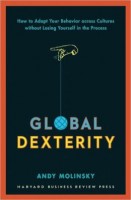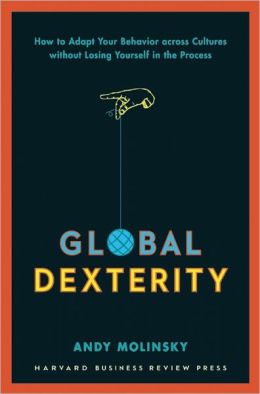 Author: Andy Molinsky
Author: Andy Molinsky
Publisher: Harvard Business Review Press – 200 pages
Book Review by: Sonu Chandiram
People involved in the business of selling American products in a highly competitive global environment need Global Dexterity. When high prices of U.S. products are a primary obstacle to generating income from overseas (as is becoming increasingly the case now with America’s shrinking manufacturing sector) export sellers need to learn to communicate the idea of value (quality, service and price) to their prospects.
Communicating any value proposition effectively means understanding the customer, particularly his or her primary pains you are trying to alleviate, or needs you are trying to satisfy. Getting business from the customer also requires understanding the market of the importing customer, particularly key competitors of his.
It also goes without saying that understanding the culture, particularly the value system of the people in a particular country, is key to doing business on a consistent basis, and even on growing scale, in that market.
If your company is exporting American-made or branded products, importing them from other countries, outsourcing (buying) services from abroad, has a company-owned or company-run sales or buying office abroad, dealing with foreign agents who buy or sell for you, has a branch of the company with any number of operations (e.g. manufacturing, research, procurement, sales, etc) this book can be helpful to you.
Even if you are just an individual thinking to buying stuff from China for example and selling them to wholesalers or retailers in the U.S. this book can be useful to you. It contains 10 short chapters simply organized into three parts, which respectively explain to you why global dexterity matters in today’s world of international commerce; how to develop your own global dexterity; and how to fine-tune it for maximum benefit to you.
The author wrote this book out of observing a gap between what written knowledge there is out there on cross-cultural issues (especially as they relate to business relationships) and what is actually needed, from a practical standpoint, to bridge that gap.
If you are an American who has traveled to Europe, you can probably easily get by because European values (e.g. individualism) and behaviors (with the freedom to make decisions yourself) are likely very similar to your own. And most people speak English. But if you travel to China for example, you are in a very different world, where family is important and government authority is widespread in all aspects of people’s lives.
So what sort of topics can you learn about in this handy book?
In Part One, you get an introduction to global dexterity and are presented with the typical challenges that most people face in developing it.
In Part Two, you learn about developing your ‘cultural code’ – a set of appropriate personal behaviors in a given culture. For example, the author cites the case of an Indian woman who was a software engineer for Citibank in Mumbai who comes to the United States to seek a job in management consulting.
In the U.S., networking events are an informal way to meet people who are in positions to offer you the kind of job you’re looking for, or can refer contacts to you. But such events are rare in India, and the job-prospecting process is restrained and usually, formal. So what the Indian woman needs to do is to develop a cultural code appropriate to pursuing a job in the United States.
The code varies for different countries, and the nuances within a code vary for different individuals. But you learn that there are six dimensions of a cultural code, which are:
- Directness
- Enthusiasm
- Formality
- Assertiveness
- Self-promotion
- Personal disclosure
In each of the above elements except formality, Molinksy points out that the cultural expectation in India is low, whereas in the United States, the reverse is the case. So in India, job seekers are expected to be less direct, enthusiastic, assertive, self-promoting, and disclosing of personal matters, but formal in their approach. In the U.S. the approach is less formal but in terms of the other qualities, jobseekers are expected to rank high, so they are more direct, enthusiastic, etc.
In Part Three, you’re shown ways to improve your own global dexterity, particularly how to chart your progress over time, get others to forgive your cultural mistakes, find a cultural mentor, and choose whether or not to adapt your behavior. The book ends with a conclusive article on the myth and reality of adapting behavior across cultures.
This is a one-of-a-kind book on developing cross-cultural insight. Like most subjects, you cannot learn it in one reading. Practice is essential. But Andy Molinsky provides you an excellent start.







